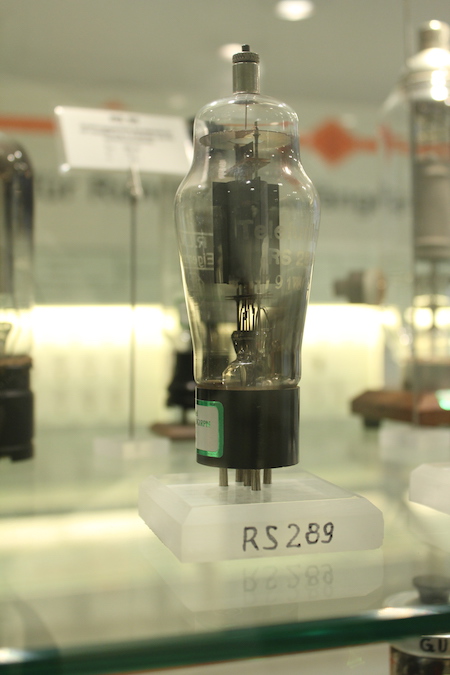energy prospects
 Sende-Pentode RS289 from radio technology museum Königs-Wusterhausen
Sende-Pentode RS289 from radio technology museum Königs-Wusterhausen
There was again a discussion with randform reader Oekologisch Interessierter about the development of nuclear energy production. The original post was in Oct. 2010 i.e. briefly before the Fukushima disaster in Mar. 2011 and the outlook cited there looked quite differently from what actually happened.
That is the Fukushima disaster was a rather heavy blow to the nuclear industry. Not only were some reactors (notably in Japan) immediately taken off the grid but the planning and construction of new reactors became -at least in some countries- politically rather problematic.
And consequently as pointed out by Oekologisch Interressierter, who cited an article (in german) by Stefanie Groll on the website of the Heinrich-Böll foundation (a foundation which is however related to the german green party, i.e. a political party which is strictly against nuclear energy) the current outlooks for the nuclear industry look not so good.
Amongst others the article by Stefanie Groll cited a report called “World Nuclear Industry Status Report 2017.” It had been written by a group of people who work in energy consulting and research.
According to this report (p.10):
The report makes clear, in telling detail, that the debate is over. Nuclear power has been eclipsed by the sun and the wind. These renewable, free-fuel sources are no longer a dream or a projection-they are a reality that are replacing nuclear as the preferred choice for new power plants worldwide.
Since I am against using nuclear fission in a commercial context (I am however supportive to nuclear research, medical applications and I have been open to fallback options) I could sit down now and rejoice.
….unfortunately this is not so easy.
Why that?
As mentioned in my comment to “Oekologisch Interessierter” in a randform post I had tried to highlight already about ten years ago (see also the overview) that the current reactor technology won’t be anymore long in use due to peak uranium and hence I was warning that this more or less may lead to the installment of breeders – a technology which is rather untested and technologically partially way more demanding than the previous fission reactor types. And so indeed in an overview by world-nuclear about planned fast breeders, there are currently 15 fast breeder reactors in the planning. It is unclear how fast the technology can and will be implemented in reality and larger installments will take place after the mid 2020s but well this means there are still enough people who think this is the pathway to go.
How realistic is it that this path will be used? -I don’t know.
Since as of today nuclear fusion or eventually other unknown possibilities look as futuristic as 10 years ago this depends amongst others also on how “regenerative energy” is able to replace the rather steep intermediate decline in nuclear, the necessary decrease of fossil burning due to climate considerations and a growing demand which is mostly due to a massive population growth, but also to a worldwide higher average energy consumption.
So its not only that breeders look still attractive as an energy option to many people but the question is whether this energy option can be at all circumvented.
The above mentioned article by Stefanie Groll cites also a report (in german/ in english) by the DIW by Claudia Kemfert et al which reports about the outcome of energy market simulations:
“…a study by the German Institute for
Economic Research shows that the Paris climate protection target—
limiting global warming to below two degrees—can be achieved
inexpensively without nuclear power. The results of a global energy
system model indicate that no new nuclear power plants have to
be built in order to meet the global climate target. It would be
cheaper to use a combination of renewable energy and energy
storage systems.”
The simulation uses the Open Source Energy Modelling System OSeMOSYS “as the basis for the GENeSYS-MOD model” (Details here).
Amongst others there had been also recent studies by the group around Mark Jacobson with the title 100% Clean and Renewable Wind, Water, and Sunlight All-Sector Energy Roadmaps for 139 Countries of the World and Studies on Grid Reliability With High Penetrations of Wind, Water, and Sunlight (WWS). The supplement of the first article seems to provide concrete rates and parameters, which are however at least partially global parameters taken as an approximation for missing country values.
How realistic are these studies? Hard to tell. An assessment depends of course a lot on how many and what kind of assumptions are made and also on the time and stamina one has to investigate these very complex models in depth. There are some funny roughly ten year old discussion snippets on Mark Jacobson’s et al works (assembled mainly by John Baez (who is by the way a proponent of nuclear energy production) ) which exemplify the difficulties.
What is meant by assumptions can be illustrated by this image (also on p. 118) in the Mark Jacobson et al article. “B.A.U.” is here an abbreviation for “Business as usual” and the here given power demand grows linearily (i.e. looks like a straight line) whereas e.g. for the population growth projections there exist several variants (image to be obtained from the World Population Prospects 2017). An interactive chart by the company Datawrapper illustrates also the regional peckularities which are connected with these developments, i.e. in particular the question where most of the population will be living.